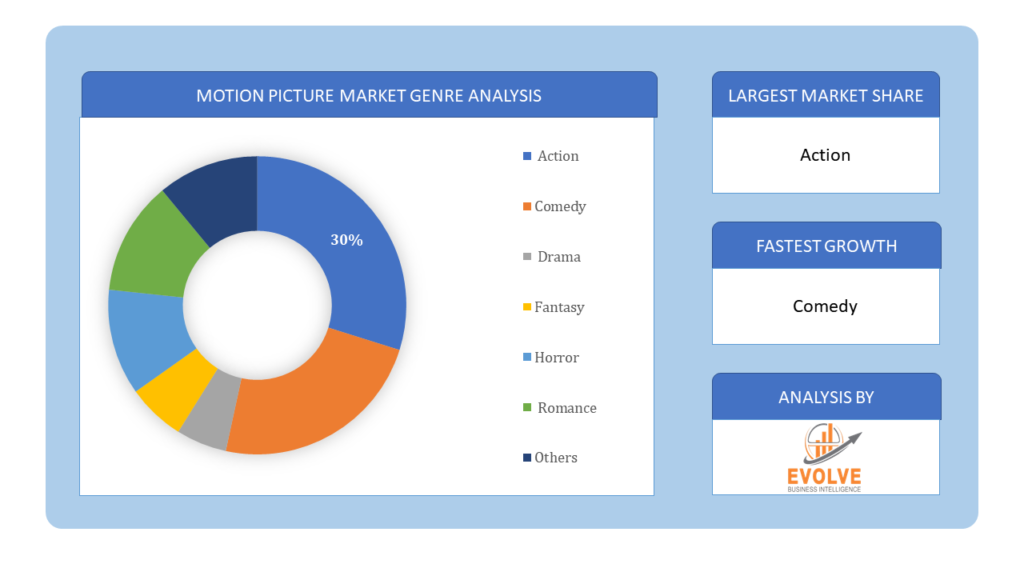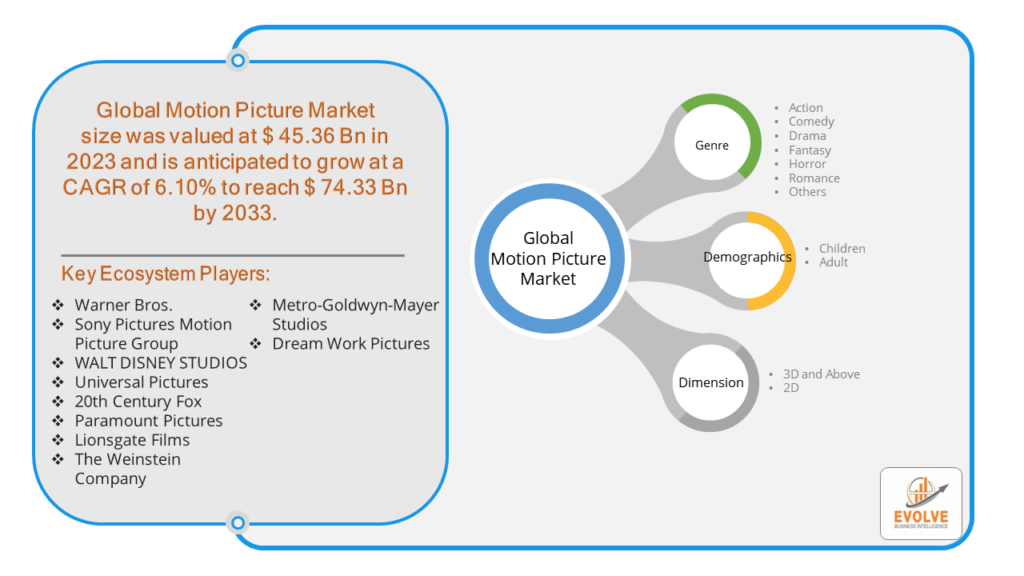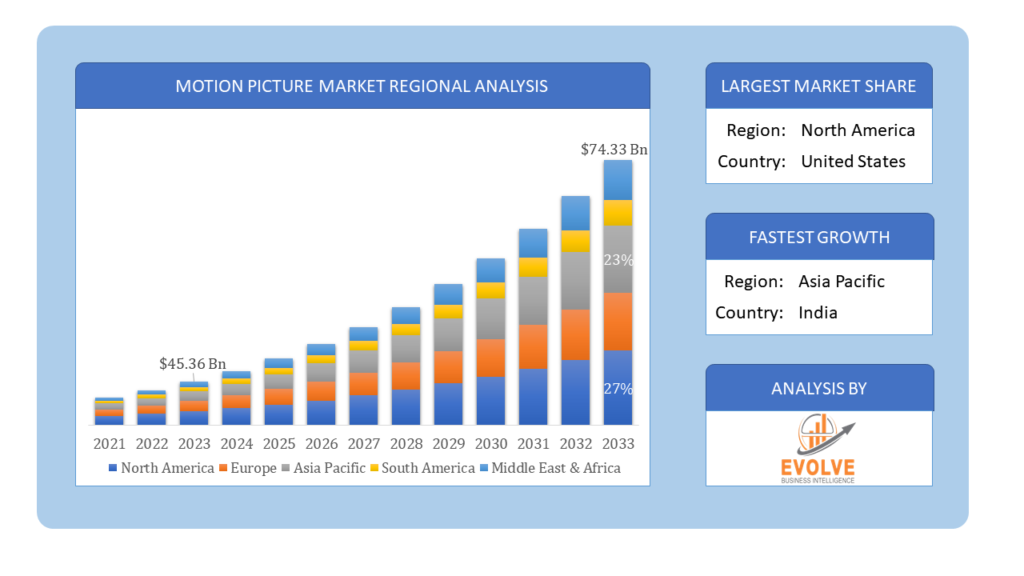Motion Picture Market Overview
The Motion Picture Market Size is expected to reach USD 45.36 Billion by 2033. The Motion Picture industry size accounted for USD 54.74 Billion in 2023 and is expected to expand at a compound annual growth rate (CAGR) of 6.10% from 2023 to 2033. The motion picture market encompasses the entire ecosystem of creating, distributing, and exhibiting films for entertainment purposes. It includes various stakeholders such as film studios, production companies, distributors, exhibitors (theaters), and streaming platforms. This global industry generates significant revenue through box office sales, streaming subscriptions, licensing deals, and merchandise. Trends in the market are influenced by technological advancements, changing consumer preferences, and global economic factors.
Global Motion Picture Market Synopsis
The COVID-19 pandemic has led to supply chain disruptions leading to supply shortages or lower demand in the Motion Picture market. The travel restrictions and social-distancing measures have resulted in a sharp drop in consumer and business spending and this pattern is to continue for some time. The end-user trend and preferences have changed due to the pandemic and have resulted in manufacturers, developers, and service providers to adopt various strategies to stabilize the company.
Global Motion Picture Market Dynamics
The major factors that have impacted the growth of Motion Picture are as follows:
Drivers:
⮚ Technological Advancements
Technological innovations continually transform the landscape of filmmaking, distribution, and exhibition. Advances in digital cameras, computer-generated imagery (CGI), and editing software enhance the quality of visuals and special effects, allowing filmmakers to create immersive experiences. Additionally, streaming platforms and video-on-demand services have revolutionized how audiences consume content, providing convenient access to a vast array of films anytime, anywhere.
Restraint:
- Competition
The proliferation of content across various platforms has intensified competition within the motion picture market. Traditional studios face competition from streaming services, independent filmmakers, and user-generated content platforms, leading to fragmented audiences and market saturation. Competition for audience attention and box office revenue necessitates substantial investments in marketing, promotion, and talent acquisition, increasing operational costs and risks for stakeholders.
Opportunity:
⮚ Innovative Distribution Models
The proliferation of streaming services, video-on-demand platforms, and digital distribution channels has revolutionized how films are consumed and monetized. Subscription-based streaming platforms offer filmmakers alternative revenue streams and direct access to global audiences, bypassing traditional distribution channels. Furthermore, innovative distribution models, such as day-and-date releases and simultaneous theatrical and digital premieres, cater to diverse audience preferences and maximize revenue potential across multiple platforms.
Motion Picture Market Segment Overview
By Genre
 Based on the Genre, the market is segmented based on Action, Comedy, Drama, Fantasy, Horror, Romance, Others. In the motion picture market, the genre segmentation reveals that Action and Comedy films often dominate due to their broad appeal and ability to attract diverse audiences seeking entertainment and escapism. These genres consistently draw large box office returns and have established themselves as perennial favorites among moviegoers worldwide.
Based on the Genre, the market is segmented based on Action, Comedy, Drama, Fantasy, Horror, Romance, Others. In the motion picture market, the genre segmentation reveals that Action and Comedy films often dominate due to their broad appeal and ability to attract diverse audiences seeking entertainment and escapism. These genres consistently draw large box office returns and have established themselves as perennial favorites among moviegoers worldwide.
By Demographics
Based on the Demographics, the market has been divided into Children, Adults. In the motion picture market segmented by demographics, films targeted at Adults typically dominate, reflecting the larger purchasing power and diverse interests of this demographic. Adult-oriented films encompass a wide range of genres and themes, catering to varying tastes and preferences, and often command significant box office success and critical acclaim.
By Dimension
Based on Dimension, the market has been divided into 3D and Above, 2D. In the motion picture market segmented by dimension, 2D films often dominate due to their widespread accessibility and lower production costs compared to 3D and above formats. While 3D and above formats offer enhanced visual experiences, 2D films remain preferred by both audiences and filmmakers for their simplicity, affordability, and compatibility with traditional exhibition platforms.
Global Motion Picture Market Regional Analysis
Based on region, the market has been divided into North America, Europe, Asia-Pacific, the Middle East & Africa, and Latin America. The area of North America is anticipated to dominate the market for the usage of Motion Picture, followed by those in Asia-Pacific and Europe.
 Motion Picture North America Market
Motion Picture North America Market
North America dominates the Motion Picture market due to several factors. In North America, the motion picture market is a leading global hub for film production, distribution, and exhibition, with Hollywood at its core. The region is characterized by a high concentration of major studios, advanced filmmaking technology, and a diverse array of content catering to broad audiences. Box office revenues are substantial, driven by blockbuster releases, strong domestic demand, and a robust theater infrastructure. Additionally, North America is a significant market for streaming services, reflecting changing consumer preferences towards digital consumption.
Motion Picture Asia Pacific Market
The Asia-Pacific region has been witnessing remarkable growth in recent years. The Asia-Pacific motion picture market is rapidly expanding, driven by significant growth in countries like China, India, and South Korea. This region boasts a large and diverse audience base, contributing to increasing box office revenues and a burgeoning film production industry. Technological advancements and the rise of regional streaming platforms are transforming film consumption patterns. Additionally, local content that resonates with cultural values and international collaborations are enhancing the global influence of Asia-Pacific’s film market.
Competitive Landscape
The competitive landscape includes key players (tier 1, tier 2, and local) having a presence across the globe. Companies such as Warner Bros., Sony Pictures Motion Picture Group, WALT DISNEY STUDIOS, Universal Pictures, and 20th Century Fox are some of the leading players in the global Motion Picture Industry. These players have adopted partnership, acquisition, expansion, and new product development, among others as their key strategies.
Key Market Players:
- Warner Bros.
- Sony Pictures Motion Picture Group
- WALT DISNEY STUDIOS
- Universal Pictures
- 20th Century Fox
- Paramount Pictures
- Lionsgate Films
- The Weinstein Company
- Metro-Goldwyn-Mayer Studios
- Dream Work Pictures
Key development:
In September 2022, Sony Pictures Motion Picture Group announced a strategic partnership with the Korean production company CJ ENM to co-produce and distribute films, aiming to expand their footprint in the burgeoning Asian market.
Scope of the Report
Global Motion Picture Market, by Genre
- Action
- Comedy
- Drama
- Fantasy
- Horror
- Romance
- Others
Global Motion Picture Market, by Demographics
- Children
- Adult
Global Motion Picture Market, by Dimension
- 3D and Above
- 2D
Global Motion Picture Market, by Region
- North America
- US
- Canada
- Mexico
- Europe
- UK
- Germany
- France
- Italy
- Spain
- Benelux
- Nordic
- Rest of Europe
- Asia Pacific
- China
- Japan
- South Korea
- Indonesia
- Austalia
- Malaysia
- India
- Rest of Asia Pacific
- South America
- Brazil
- Argentina
- Rest of South America
- Middle East & Africa
- Saudi Arabia
- UAE
- Egypt
- South Africa
- Rest of Middle East & Africa
| Parameters | Indicators |
|---|---|
| Market Size | 2033: $74.33 Billion |
| CAGR | 6.10% CAGR (2023-2033) |
| Base year | 2022 |
| Forecast Period | 2023-2033 |
| Historical Data | 2021 |
| Report Coverage | Revenue Forecast, Competitive Landscape, Growth Factors, and Trends |
| Key Segmentations | Genre, Demographics,Dimension |
| Geographies Covered | North America, Europe, Asia-Pacific, Latin America, Middle East, Africa |
| Key Vendors | Warner Bros., Sony Pictures Motion Picture Group, WALT DISNEY STUDIOS, Universal Pictures, 20th Century Fox, Paramount Pictures, Lionsgate Films, The Weinstein Company, Metro-Goldwyn-Mayer Studios, Dream Work Pictures |
| Key Market Opportunities | • Creative Content Generation and Personalization |
| Key Market Drivers | • Advancements in AI research and technology • Growing demand for personalized and creative content |
REPORT CONTENT BRIEF:
- High-level analysis of the current and future Motion Picture Industry trends and opportunities
- Detailed analysis of current market drivers, restraining factors, and opportunities analysis in the future
- Historical market size for the year 2021, and forecast from 2023 to 2033
- Motion Picture market share analysis for each segment
- Competitor analysis with a comprehensive insight into its product segment, financial strength, and strategies adopted.
- Identifies key strategies adopted by the key players including new product development, mergers and acquisitions, joint ventures, collaborations, and partnerships.
- To identify and understand the various factors involved in the global Motion Picture market affected by the pandemic
- To provide year-on-year growth from 2022 to 2033
- To provide short-term, long-term, and overall CAGR comparison from 2022 to 2033.
- Provide Total Addressable Market (TAM) for the Global Motion Picture Market.








